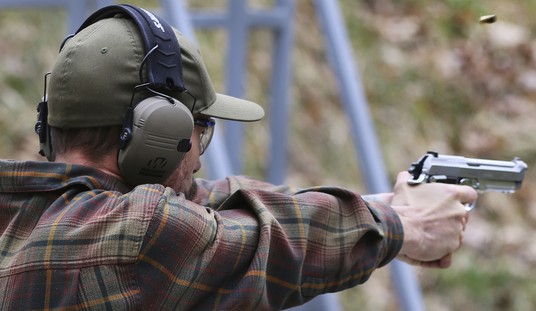 The unique aesthetics of the S&W Performance Center’s Model 327 revolver immediately attract attention on dealers’ shelves. It shocks the visual senses. First, the large-frame chassis combines with two-inch barrel sports Cocobolo wood round butt finger groove grips from Ahrends. To give the reader a sense of scale, the frame is derived from the Model 29 .44 Magnum N-frame. The oversized titanium cylinder holding eight rounds of .357 Magnum is another clue that something out of the ordinary is going on. The proprietary S&W barrel lock nut, which mates the stainless steel barrel insert to barrel shroud, is another anomaly. Finally, the combination of three different manufacturing materials–alloy frame, stainless steel barrel, and titanium cylinder and barrel shroud–confirms that the Model 327 is not your ordinary revolver.
The unique aesthetics of the S&W Performance Center’s Model 327 revolver immediately attract attention on dealers’ shelves. It shocks the visual senses. First, the large-frame chassis combines with two-inch barrel sports Cocobolo wood round butt finger groove grips from Ahrends. To give the reader a sense of scale, the frame is derived from the Model 29 .44 Magnum N-frame. The oversized titanium cylinder holding eight rounds of .357 Magnum is another clue that something out of the ordinary is going on. The proprietary S&W barrel lock nut, which mates the stainless steel barrel insert to barrel shroud, is another anomaly. Finally, the combination of three different manufacturing materials–alloy frame, stainless steel barrel, and titanium cylinder and barrel shroud–confirms that the Model 327 is not your ordinary revolver.
Comparing the Model 327 to snubby revolvers is inevitable, but misplaced in my opinion. The Model 327 is certainly not going to fit in your front pants pocket, and should not be thought of as a snubby on steroids. The S&W 327 is a primary concealed carry handgun, not a backup weapon.
In choosing a carry handgun, practitioners must consider size, weight, capacity, and cartridge potency. The one trait that can not be compromised is reliability. Revolver aficionados always lay claim to reliability as a hallmark feature. With the eight-shot .357 Magnum Model 327, revolver lovers have a weapon featuring the same capacity as the legendary 1911 pistol. In a nutshell, some individuals are just more comfortable carrying a revolver. This can be based on several threads of reasoning: prior training and familiarity with revolvers, inherent reliability and simplicity compared to semi-automatics, no external controls necessary to get a revolver into action, ability to better manage trigger control with a double-action revolver, and greater physical requirements of operating an automatic’s slide compared to a revolver’s operations. The S&W Model 327 magnifies all of the revolver’s positive traits and minimizes revolver weaknesses such as capacity and size.
The S&W Model 327’s eight-round capacity gives a 33 percent increase in firepower over six-holed revolver cylinders. The .357 Magnum cartridge represents the near-perfect combination of controllability, power, accuracy, and lethality in a pistol cartridge. I challenge the reader to add up the foot pounds (ft/lbs) of energy stored in the Model 327’s cylinder and compare it to the number of 9mm, .40 S&W, or .45 ACP rounds required to equal that amount of energy. Eight, 125-gr .357 Magnum rounds combine for 4,992 ft/lbs of energy. To equal this you need 15 rounds of 9mm, 11 rounds of .40 S&W, and 13 rounds of .45 ACP. This is not a scientific study, but I think it gets my point across.
The inclusion of moon clips with the Model 327 shows the S&W Performance Center’s attention to detail. The ability to use either moon clips or regular loading methods is a feature reserved for high end pistolsmith work. The moon clips greatly reduce reload times and make it more convenient to carry extra ammunition. Other S&W Performance Center tweaks found in the Model 327 include the Lothar-Walther custom barrel featuring polished button rifling. The custom barrel is secured inside the titanium barrel shroud by a special lock nut system used by S&W. A Wolff mainspring and traditional sear ensure a smooth double action trigger.
The single action trigger measured a crisp 3.5 lbs with no creep, using a RCBS trigger gauge. Range testing utilized Black Hills Ammunition, Winchester, Hornady, and Federal ammunition. Both .38 Special and .357 Magnum loads were used with bullet weights of 125 gr, 140 gr, and 158 gr loads. A huge benefit for anyone who carries a .357 Magnum revolver is the ability to practice with .38 Special loads; they are more economical and not as harsh in terms of recoil and muzzle blast as the magnum loads. The importance of this is not something to be underestimated. I practice with .38 Special rounds when I want to work on shooting fundamentals without wrestling with the .357’s full power recoil and muzzle blast. Practice with .38 Special ammunition aids in building confidence, and exposes recoil-induced bad habits.
My two adolescent sons had no problems controlling the 21 ounce Model 327 when firing .38 Special loads. The large-frame grip size deserves much of the credit for this. Full power .357 Magnum loads proved problematic and uncomfortable for them. The two-inch barreled Model 327 does cause quite a stir when shooting .357 Magnum loads, with the 125 gr varieties seemingly producing more muzzle flash and blast than the heavier bullet loads. I found the two inch barrel more than adequate for a personal defense revolver. A longer barrel would only have diminishing returns by increasing weight and complicating concealability without contributing much more to the potency of the weapon.
Range evaluation consisted of a test regimen of engaging multiple steel and paper targets, firing while moving, reloading from cover, and engaging targets from behind barricades. The moon clips proved a definite advantage in reloading during these scenarios. I did not bench rest the S&W Model 327, as I feel this is worthless information for a handgun with a two inch barrel. The Model 327 with its fixed rear sight and red front ramp proved more than capable of ringing steel targets 25 yards away. In fact, when having the time to deliberately aim and fire, steel man targets more than 100 yards away were not safe. That is more than enough accuracy for a personal defense handgun. One quirk I discovered with the S&W Model 327 is that empties did not fall free from the cylinder no matter how hard the ejector rod is struck. Close scrutiny determined that the ejector rod could not have been made any longer to remedy the problem. I do not want to make too big of a deal of this, because a quick swipe of the hand dropped the cases free before sliding in another eights rounds via moon clip.
Another side note to my range experience is that after thousands of rounds fired through automatic handguns, I quickly relearned that revolvers require a slightly different firing grip. Thumbs ahead do not work well next to a revolver’s cylinder. Thumbs need to be curled inward toward the frame. This lesson was learned early in nearly 500 rounds fired during numerous range visits.
Holster choices are limited for the S&W revolver at this time. However, Smith & Wesson has teamed up with holster maker DeSantis to offer a Speed Scabbard belt holster for the Model 327, which is offered exclusively through Smith & Wesson. This eases any customer concerns over how to carry the Model 327 once purchased. The DeSantis Speed Scabbard carries the Model 327 high and tight to the body, which aids concealment. The Speed Scabbard provides good retention, while still allowing for quick presentation when needed.
The DeSantis Speed Scabbard is typical of quality leather holsters in that a break-in period is necessary. When I first held the holster in my hand and casually inserted the Model 327, there were no issues removing the revolver from the holster. However, once the DeSantis Speed Scabbard was belted on my hip it got interesting. It still causes a smile to cross my face when I remember my oldest son rolling on the floor, laughing hysterically, as I tried to no avail to draw the revolver from the Speed Scabbard. He said it looked like I was trying to “rip my pants off.” Humorous as it was, it reinforced an important lesson in always fully testing gear before committing to using it for concealed carry. A few nights of placing the Model 327 in a thin sock before holstering, constant dry drills, and numerous range visits got the DeSantis Speed Scabbard properly broken in. Once done, I carried the Model 327 confidently knowing it would stay secure until needed.
The Model 327 will not be employed on a square range when it is really needed. The chance to acquire the front sight and pull the trigger smoothly to the rear may not happen. This is how I arrived at the Crimson Trace Corporation Lasergrips (CTC) Model LG-314. The CTC Lasergrip allows for aimed fire while keeping the weapon close to the body or from any other unorthodox position. Another CTC advantage is that I did not have to give up the DeSantis Speed Scabbard holster. The CTC laser mounted high on the grip area does not change any frame dimensions and negates the need for a custom holster. The CTC grips for the Model 327 are square butt versus the Ahrends round butt wood grips. Some may argue that this increases the difficulty of concealing the revolver, but I maintain that CTC grips are proper grips in their own right, not just a vehicle to mount the laser. Some users will prefer CTC laser grips for what is offered as a pistol grip without even taking into account the laser feature. The CTC grips are a force multiplier in my opinion, worth the minimal dimension increase.
The Crimson Trace Lasergrip did take a little getting used to as an aiming device. The laser’s advantage rests in the natural tendency to focus on the imminent threat rather than the front sight interposed between the threat and the shooter. The laser will be seen on the target where the eye is naturally drawn. I found the key to success is to look at the target, pick up the flash of the laser, and squeeze off the round without referencing the fixed sights. Shooters have to gain confidence that the bullet will strike where the laser is aimed. This is achieved with practice. Training with iron sights puts so much emphasis on sight picture that it takes time to get used to finding the laser on the intended target without referencing the front sight. Trust me, once the CTC Lasergrip is properly sighted in, the bullet will hit where the laser is projected.
The S&W Model 327 is a viable personal defense handgun that levels the playing field between revolvers and semi-automatic handguns. The Model 327 is no small snubby and should be thought of as an equal to the 1911 and high capacity polymer handguns. Some will not abandon the classic 1911, while others will not forego the high capacity polymer frames. As with most things related to firearms, handgun selection is a personal decision often based more on intuition than fact based reasoning. Eight rounds of .357 Magnum in a reasonably sized, light weight, reliable package will bring many handgunners back to the revolver fold. It is a viable concealed carry firearm for people looking for something more than a small .38 Special revolver, and something less complicated than a large semi-auto pistol.








Join the conversation as a VIP Member